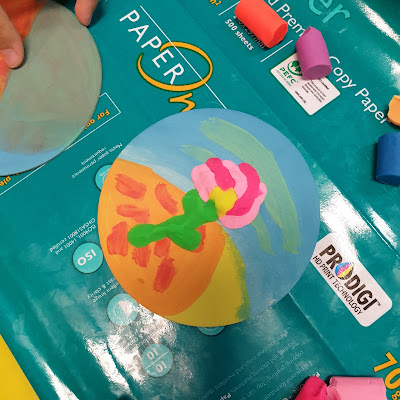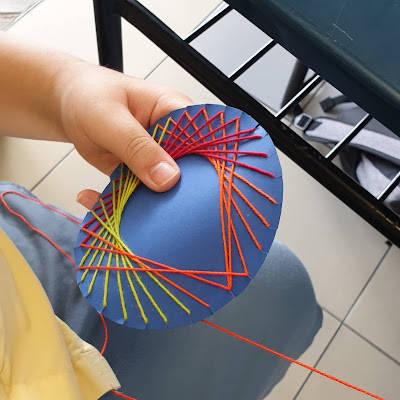Hi! The children have completed their watercolour painting last week. To reiterate the learning outcomes from the previous lesson, they sort the air-dry clays according to warm and cool colours again.
Tabs under construction!
Sunday, September 19, 2021
Art Class: Clay Relief Work
Sunday, September 5, 2021
Art Class: Watercolour Painting for Beginners
Hi Teachers! The Primary One students have started using watercolour cakes to paint. We watched an instructional video in the previous lesson and talked through the things to bring for the following lesson. The children wrote down the one thing to bring - an empty container to hold water.
Now, there are a few points to make clear when you entrust the children to bring an important piece of material. Because no container = no painting. I've explained that I don't have enough for everyone. So, if they have, they should bring the containers the next day and labelled with their name and class with a permanent marker and kept in the art cupboard lest they forget if they wait until the next art class (weekly art class).
The painting day arrived and some students had forgotten to bring a container. Last week, a boy from one of the Primary One classes came up to me the moment I entered his classroom. He repeatedly thanked me for teaching him an important lesson that day and said that he will not forget to bring important things again. I was quite impressed by his response.
Children without water containers were given a set of coloured pencils instead. I mean what I said. And this reputation goes a long way and essential for classroom management. They could still practise the use of Warm and Cool colours even though the medium has changed.
I mostly rejected the use of lunchboxes as water containers and the best try goes to a kid who wanted to use a pen cap as a container. Yes, anything that looks like a vessel😭
Most children had painting experience but they will still enjoy when asked to do it. Thus, asking them to bring something isn't that difficult because responsibility is taught by leveraging on this activity. I do bring a few containers to class in case a child's container has cracked. Sometimes, it irks me to delay the lesson unit due to small hiccups but I try to think of the long-term benefit over the short-term inconvenience.
Sunday, August 29, 2021
Art Class: Printmaking
Hi Teachers! I have a new teacher, Ms J, joining me in my art classes this year. We started co-teaching the Printmaking unit. Ms J adapted some current resources and added new ideas of her own. The tuning-in activity included printing with LEGO bricks. She brought some from home and got the students to try printing with acrylic paint. It's funny how sometimes I think teaching is probably the only career that is widely acceptable to bring things from home for work purpose.
The uniform LEGO bricks produces interesting textures and shapes. While it might seem easy to carry out the activity, we had to remind them that the amount of paint that is picked up by the brick will determine if the print can be seen clearly. There is a way to coat the paint evenly before printing without the use of brayer in this case. Another point to note is that students have a tendency to use the brick like a paintbrush so the imprint of the LEGO bricks is not visible.
In the following lesson, students watched a video on making collograph and they sketch out a robot collography on their sketchbook. It's inherently important to discuss some common 'mistakes' in Printmaking because there are just too many elements to watch out for. It's great if students can just discover these elements but that would mean some students will not feel successful when the time runs out. As students need to do more than one print to get their ideal ones, they show the deconstructed parts of their sketch first and then transfer the drawings to a piece of foam before cutting and pasting them on a piece of cardboard. Next, the placement of the parts also determine the intricacies of the final print. Having the parts pasted without gaps would just yield a big blob of ink while gaps that are too distance will make the work looks sparse.
Sunday, June 6, 2021
Art Class: Places of Interest in Singapore
Towards the end of Term 2, my youngest students learnt about the places of interest locally. They were all excited to share about the places they have visited and I conclude that a high percentage of the children have visited Universal Studio and Sentosa whereas there is less awareness about our historical sites.
We discussed about the activities that happened at Singapore River and the Cleanup that took 10 years. I showed them some black and white photographs of Singapore River in its dire state. Paintings by pioneer artists which is related to the Singapore River were also discussed. Some children volunteered to do a role play on what they would do if they live by the river while the rest guessed.
We spent a lesson drawing and cutting the river out from our painted paper made in the previous art class. Then, the children pasted them in their sketchbooks. The rest of the details were drawn in markers.
Wednesday, June 2, 2021
Art Class: SG75
Hi Teachers! We had our Child-Teacher-Parent Conference just last week and now it's the start of the school vacation. This month, my students are participating in SG75, an arts-based competition. In 2040, we will celebrate 75 years of Singapore. According the website, SG75 was chosen because it is far enough for us to envision and to make good plans - yet near enough for us to see these plans take shape. It calls for thinking about and preparing for future challenges. I designed worksheets for different levels and made a video to go with the activity. You can check out sg75.sg for more details.
Sunday, May 23, 2021
Art Class: Cardboard String Art
Hi Teachers! Have you watched the video about true cyan? Last few weeks, the students went through the lesson unit on Optical Illusion. It's a hit with children because it offers weird and interesting truths about the nature of perception and colours. You can search Youtuber Zack King's videos for some brilliantly-stitched videos that are quite magically. I brought string art artmaking back due to popular demand its accessibility. I'm quite surprised to hear that many students do not have strings or threads at home. We have been doing mostly solo work or work that don't requires a lot of movement in the classroom. Thus, the materials used are quite economical. It's light and handy in case students need to bring them home to complete.
On another note, Singapore schools moved online last Wednesday. The press release was on a weekend so we had time to prepare and distribute materials to our affected classes on the first two days of the week. The students were just tidying up their artwork for Term 2 and it seems like I can only see their final work in Term 3. When school term ends this month, we will still be in the midst of Phase Two. I'm working on something for the students to participate during the school vacation. Please check back!
Sunday, May 9, 2021
Art Class: Painting Routines
Hi! The children have started painting with water. I like using the coloured crepe papers for this lesson to talk about the painting routines. So when we are ready to proceed to using the actual paint pigment, the children are familiar with the routines and movement:
- clutter-free desk
- half-filled water container
- water container placed in the top center of the desk
- given only one paintbrush
- must place recycled paper underneath the watercolour paper
- tear the 'magical papers' and keep them under the water container
- hold the recycled paper lengthwise with both hands and bring to the drying rack
- rinse the paintbrush and water container
Instructions such as the amount of water to use is learnt through practice. Some children need more reminders so rest assured after a few practices, they will remember the routines. Take swimming for example, you can listen to explanation after explanation and watch many swimming videos. By not getting into the pool, how would you learn to swim? When all the children are in their painting mode, you could hear the pin drop! But the silence doesn't last long. 😹
Sunday, April 18, 2021
Art Class: Painting With Water
Hi Teachers! I used to save all my videos in my thumb drive but I run the risk of losing them if my external drive fail to work. Since our school has wireless network, it has been a breeze to upload teaching videos online and retrieving them easily during class. I hop from class to class with my laptop now. Attached is an old video for comparison purposes. The current videos contain video thumbnails to make video search easier. Content wise, the newer videos show wider angle perspective to capture more activities. That said, investing in suitable video equipment to create the content that you need is important too. What are we doing with the painted papers? Check out in my next post!
Sunday, April 11, 2021
Art Class: How to Transform Yourself into a Cyborg (Part II)
Hi Teachers! We had a good laugh in class last week. I showed everyone's work under the visualiser (document camera) and it generated much reactions. Check out my previous post here. The children didn't mean to laugh at their peers' work in a bad way. It's entertaining to see the children imagine their friends looking like hand drawn cyborg in real life.
The children had some practice with drawings of smaller versions of the robots before committing to drawing on the coloured papers. I find this practice useful for most art tasks as it strengthens their stamina in drawing. Some children do claim that their hands are tired from drawing after a while. The reason I use an A3-size papers is also to increase the visual impact of their efforts. They use bold chisel tip marker for better grip that also highlight the visual effects compared to just making do with pencil lines. The marker ink does bleed through the coloured papers so they put the back of their sketchbook underneath to catch the ink.

















































